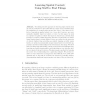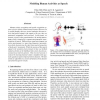627 search results - page 50 / 126 » Structural Learning of Activities from Sparse Datasets |
ECCV
2008
Springer
14 years 10 months ago
2008
Springer
The sliding window approach of detecting rigid objects (such as cars) is predicated on the belief that the object can be identified from the appearance in a small region around the...
ENGL
2007
13 years 8 months ago
2007
—“A General Reflex Fuzzy Min-Max Neural Network” (GRFMN) is presented. GRFMN is capable to extract the underlying structure of the data by means of supervised, unsupervised a...
CVPR
2011
IEEE
13 years 4 months ago
2011
IEEE
Human activity recognition and speech recognition appear to be two loosely related research areas. However, on a careful thought, there are several analogies between activity and ...
IJCAI
2007
13 years 10 months ago
2007
This paper presents an algorithm for inferring a Structured Hidden Markov Model (S-HMM) from a set of sequences. The S-HMMs are a sub-class of the Hierarchical Hidden Markov Model...
ICCV
2011
IEEE
12 years 8 months ago
2011
IEEE
We present a hierarchical model that learns image decompositions via alternating layers of convolutional sparse coding and max pooling. When trained on natural images, the layers ...


